Plextor M3 Pro (256GB) Review
by Kristian Vättö on July 1, 2012 1:45 PM ESTAnandTech Storage Bench 2011
Last year we introduced our AnandTech Storage Bench, a suite of benchmarks that took traces of real OS/application usage and played them back in a repeatable manner. Anand assembled the traces out of frustration with the majority of what we have today in terms of SSD benchmarks.
Although the AnandTech Storage Bench tests did a good job of characterizing SSD performance, they weren't stressful enough. All of the tests performed less than 10GB of reads/writes and typically involved only 4GB of writes specifically. That's not even enough exceed the spare area on most SSDs. Most canned SSD benchmarks don't even come close to writing a single gigabyte of data, but that doesn't mean that simply writing 4GB is acceptable.
Originally we kept the benchmarks short enough that they wouldn't be a burden to run (~30 minutes) but long enough that they were representative of what a power user might do with their system. Later, however, we created what we refer to as the Mother of All SSD Benchmarks (MOASB). Rather than only writing 4GB of data to the drive, this benchmark writes 106.32GB. This represents the load you'd put on a drive after nearly two weeks of constant usage. And it takes a long time to run.
1) The MOASB, officially called AnandTech Storage Bench 2011—Heavy Workload, mainly focuses on the times when your I/O activity is the highest. There is a lot of downloading and application installing that happens during the course of this test. Our thinking was that it's during application installs, file copies, downloading, and multitasking with all of this that you can really notice performance differences between drives.
2) We tried to cover as many bases as possible with the software incorporated into this test. There's a lot of photo editing in Photoshop, HTML editing in Dreamweaver, web browsing, game playing/level loading (Starcraft II and WoW are both a part of the test), as well as general use stuff (application installing, virus scanning). We included a large amount of email downloading, document creation, and editing as well. To top it all off we even use Visual Studio 2008 to build Chromium during the test.
The test has 2,168,893 read operations and 1,783,447 write operations. The IO breakdown is as follows:
| AnandTech Storage Bench 2011—Heavy Workload IO Breakdown | ||||
| IO Size | % of Total | |||
| 4KB | 28% | |||
| 16KB | 10% | |||
| 32KB | 10% | |||
| 64KB | 4% | |||
Only 42% of all operations are sequential; the rest ranges from pseudo to fully random (with most falling in the pseudo-random category). Average queue depth is 4.625 IOs, with 59% of operations taking place in an IO queue of 1.
Many of you have asked for a better way to really characterize performance. Simply looking at IOPS doesn't really say much. As a result we're going to be presenting Storage Bench 2011 data in a slightly different way. We'll have performance represented as Average MB/s, with higher numbers being better. At the same time we'll be reporting how long the SSD was busy while running this test. These disk busy graphs will show you exactly how much time was shaved off by using a faster drive vs. a slower one during the course of this test. Finally, we will also break out performance into reads, writes, and combined. The reason we do this is to help balance out the fact that this test is unusually write intensive, which can often hide the benefits of a drive with good read performance.
There's also a new light workload for 2011. This is a far more reasonable, typical every day use case benchmark. It has lots of web browsing, photo editing (but with a greater focus on photo consumption), video playback, as well as some application installs and gaming. This test isn't nearly as write intensive as the MOASB but it's still multiple times more write intensive than what we were running last year.
We don't believe that these two benchmarks alone are enough to characterize the performance of a drive, but hopefully along with the rest of our tests they will help provide a better idea. The testbed for Storage Bench 2011 has changed as well. We're now using a Sandy Bridge platform with full 6Gbps support for these tests.
AnandTech Storage Bench 2011—Heavy Workload
We'll start out by looking at average data rate throughout our new heavy workload test:
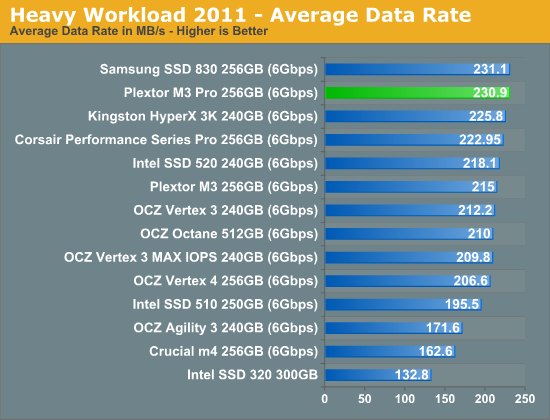
I think it's safe to say that the M3 Pro shares the title of the fastest drive with Samsung SSD 830 in our Heavy suite as the difference between the two is only 0.2MB/s, which is well under the margin of error between runs. When compared with the M3, the M3 Pro is 16MB/s (~7%) faster, which is quite significant when taking into account that these drives share the same hardware. Overall the M3 Pro has outstanding performance for a Marvell based drive and it actually beats all the 240GB SandForce based SSDs we have tested in overall performance for our Heavy scenario.
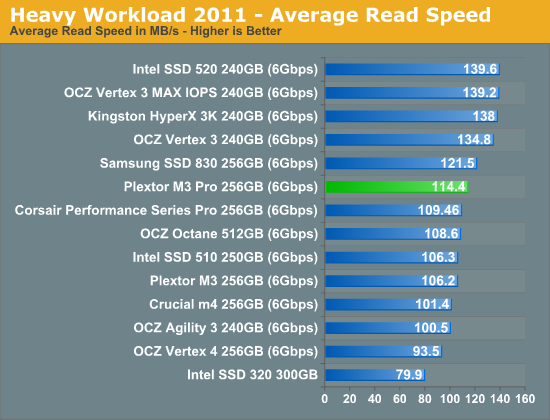
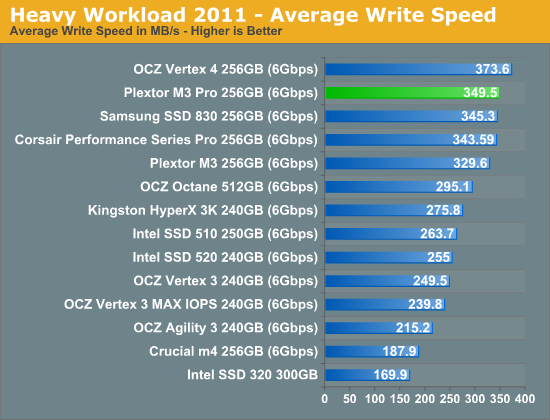
Looking at average read and write speeds, the M3 Pro offers middle-of-the-pack read performance while coming in near the top in read performance--second only to the OCZ Vertex 4. SF-2281 drives go the other route, with typically better read performance but lower write performance (at least with our test data that generally isn't highly compressible).
The next three charts just represent the same data, but in a different manner. Instead of looking at average data rate, we're looking at how long the disk was busy for during this entire test. Note that disk busy time excludes any and all idles; this is just how long the SSD was busy doing something:
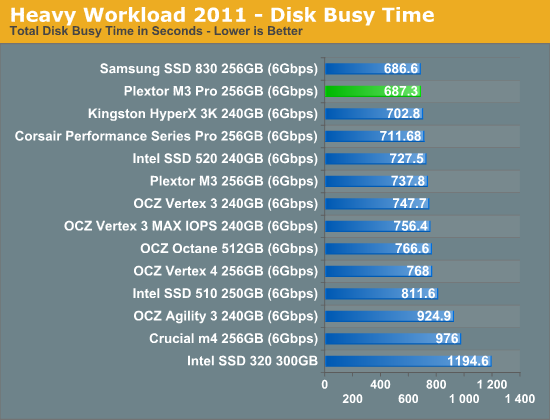

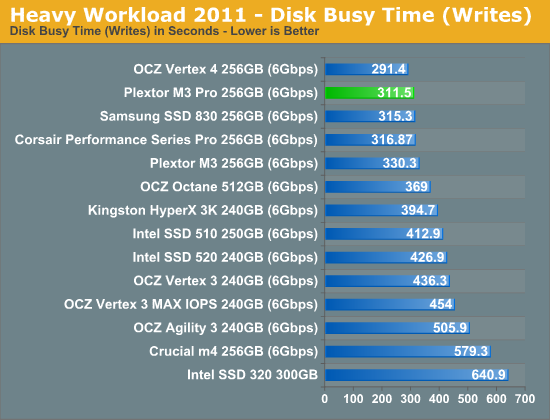










55 Comments
View All Comments
Chaitanya - Sunday, July 1, 2012 - link
I associate names like plextor and lite-on with optical discs. now they are into solid state media as well. wondering whats next.DaFox - Sunday, July 1, 2012 - link
Plextor was amazing back when optical drives were relevant.iamkyle - Sunday, July 1, 2012 - link
You mean, before they stopped manufacturing their own driveslexluthermiester - Sunday, July 1, 2012 - link
Quote; "back when optical drives were relevant."Last time I checked, optical drives are still in very common use for a wide variety of purposes. How are they not still relevant?
HisDivineOrder - Sunday, July 1, 2012 - link
There was a time when a new CD-ROM or DVD-ROM would have people scouring the web for reviews because the new drive would offer greater and greater speeds.Nowadays, people just buy whatever's cheapest or goes good with their case. They MAY look at compatibility with discs beforehand, but often don't if they're looking at a $20 DVD-/+RW. If they do, that's a few user reviews and then bam, bought. If it's crap, they throw it away and buy another.
This is far from the ancient times when a CD-ROM or DVD-ROM would warrant a full-on review with technical read-outs, minor speed differences against other models, etc. There's no point now because they're so cheap and there are no new advances being done in the field because USB storage (flash and hard drives) became so damn cheap along with the proliferation of online with digital storage.
There's a new hotness in town and we should all queue up the Toy Story sad music for ODD's. I imagine all my ODD's talking in the dusty, plastic bin of forgotten tech. They scramble out and reminisce about the times I used to have with them. The old Lite-On DVD-RW chatting with a Plextor CD-RW. A 2x DVD-ROM by Creative talking to a Pioneer DVD-slot. Every now and then, a Zip drive crying, "Hai guyz! Im hear two!"
And them all looking at him, patting him on the head, and saying, "Adults are speaking." Then lil' Zip drive'll look down and mumble something about how he used to be awesome. Meanwhile, my Sound Blaster, Sound Blaster 16, Sound Blaster AWE, Audigy, Audigy 2ZS, Aureal, Diamond 3dFX Voodoo, Voodoo 2 SLI, Matrox G200, they all chat amongst themselves about the days back when PC's were actually hard to build, compatibility was a shot in the dark and a prayer bound by McGuyver's chewing gum, and when installing Windows involved starting it and wandering away for 10 minutes (or less).
The best days are behind us, I think. Strange how the easier things get, the less awesome they feel.
erple2 - Monday, July 2, 2012 - link
If these posts were rated, you sir, would receive a +1 from me. Trips down memory lane are always fun to do now and again. I remember amber buying my first Texel drive in the very early 90s because they were so Mich more reliable, and faster.Those were truly the halcyon days...
speculatrix - Monday, July 2, 2012 - link
+1So much of what used to be hard is now trivial, and the young generation really don't need to understand how computers work. Sure that's no bad thing for productivity, but means we're raising new generations who are unable to design the next generation of hardware.
Here is Cambridge England I see the average age of engineers rising all the time. Companies struggle to find truly gifted embedded skills.
StevoLincolnite - Monday, July 2, 2012 - link
Ah, the good old days of setting individual jumpers for a CPU's FSB, multiplier and voltage... Needing a dedicated cable that goes from your optical disk drive to your sound card JUST so you can play Audio...Setting IRQ's in the bios/windows... Fun days for the tinkerer.
Now everything is just plug and play pretty much.
versesuvius - Monday, July 2, 2012 - link
Let's see an Apple (McIntosh) user go down the memory lane. I suppose theirs turns out to be 1 centimeter in length. Something like:"It was always like this. We paid triple the amount a Windows user did. Then again we were always better than them. Steve Jobs may be gone, but we are still better than them. We are just better. Long live Steve."
Just joking, of course.
tjoynt - Monday, July 2, 2012 - link
+1 Internets to you Sir or Mam! Thank you for bringing me down memory lane and reminding me how difficult and exciting it used to be. :) Now that everything pretty much Just Works, much of the fun and mystery is gone.Sure I follow the next hotness too, but building a computer today is like building with legos: just follow the pictures and snap it together. No more IRQ conflicts or DMA errors. RAM incompatibility is still a source of "fun" but that has always been annoying rather than interesting.
Sure, we can focus on actually Getting Things Done now, but so can everyone else. Being a hardware geek is not as special anymore. Of course the complexity and flakiness of software will keep us well-rounded geeks well entertained (and employed) for quite a while to come. :)